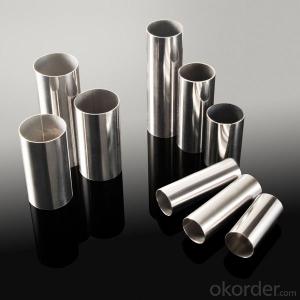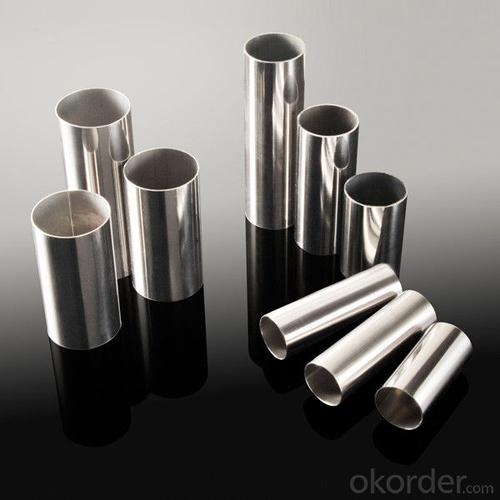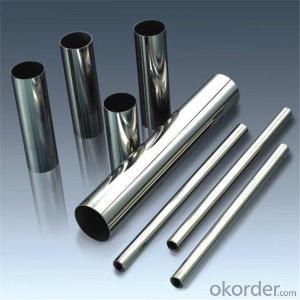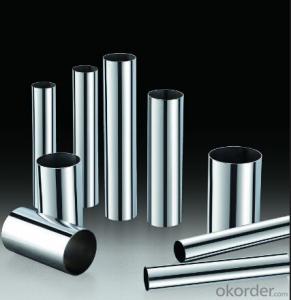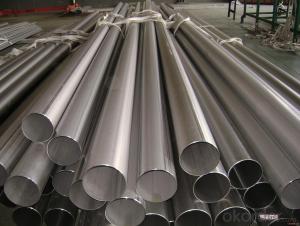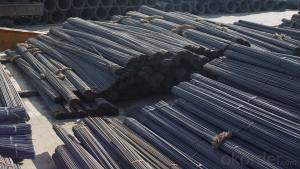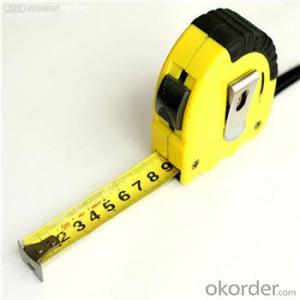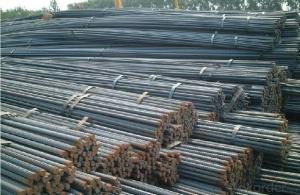Steel pipe from a good Chinese corporation
- Loading Port:
- Tianjin
- Payment Terms:
- TT OR LC
- Min Order Qty:
- 1 m²
- Supply Capability:
- 100 m²/month
OKorder Service Pledge
OKorder Financial Service
You Might Also Like
Specification
1.Structure of Seamless Pipe ASTM A106/53:
Seamless pipe is formed by drawing a solid billet over a piercing rod to create the hollow shell. As the manufacturing process does not include any welding, seamless pipes are perceived to be stronger and more reliable. Historically seamless pipe was regarded as withstanding pressure better than other types, and was often more easily available than welded pipe.
2.Main Features of the Seamless Pipe ASTM A106/53:
• High manufacturing accuracy
• High strength
• Small inertia resistance
• Good visual effect
• Reasonable price
| Tensile Strength (MPa) | ≥1080(110) | ||
| Yield strength(MPa) | ≥930(95) | ||
| Elongation(%) | ≥12 | ||
| Reduction of area(%) | ≥45 | ||
| Akv (J) | ≥63 | ||
| Impact roughness(J/cm2) | ≥78(8) | ||
| Hardness | ≤217HB | ||
| Specimen size | 25mm |
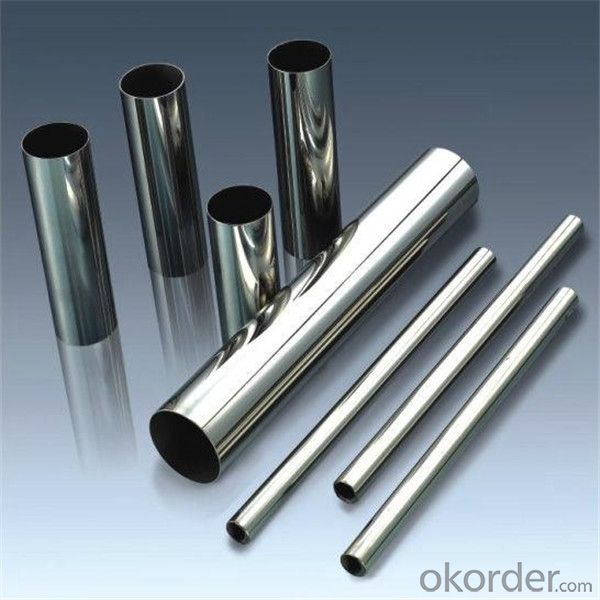
6.FAQ of Seamless Pipe ASTM A106/53:
A. How is the quality of your products?
Our products are manufactured strictly according to national and internaional standard, and we take a test on every pipe before delivered out. If you want see our quality certifications and all kinds of testing report, please just ask us for it.
Guaranteed: If products’ quality don’t accord to discription as we give or the promise before you place order, we promise 100% refund.
B.How about price?
Yes, we are factory and be able to give you lowest price below market one, and we have a policy that “ for saving time and absolutely honest business attitude, we quote as lowest as possible for any customer, and discount can be given according to quantity”,if you like you think, just don’t waste your time.Please trust the quotation we would give you, it is professional one.
C.Why should you chose us?
Chose happens because of quality, then price, We can give you both.Additionally, we can also offer professional products inquiry, products knowledge train(for agents), smooth goods delivery, exellent customer solution proposals.
Any question, pls feel free to contact us !
- Q: What are the different types of steel pipe coatings for nuclear power plants?
- There are several different types of steel pipe coatings used in nuclear power plants. These include epoxy coatings, fusion bond epoxy (FBE) coatings, polyethylene (PE) coatings, and coal tar enamel (CTE) coatings. Each coating has its own specific properties and advantages, such as corrosion resistance, chemical resistance, and abrasion resistance, to ensure the durability and longevity of the steel pipes in the demanding nuclear power plant environment.
- Q: How are steel pipes used in the telecommunications industry?
- Steel pipes are commonly used in the telecommunications industry for various purposes such as underground cable installation, protection of fiber optic cables, and support of communication towers.
- Q: Are steel pipes suitable for use in acidic environments?
- No, steel pipes are generally not suitable for use in acidic environments because they are prone to corrosion in such conditions.
- Q: What are the different types of steel pipe unions?
- There are several different types of steel pipe unions that are commonly used in various industries and applications. Some of the most common types include: 1. Threaded Union: This type of union has female threads on both ends, allowing it to be easily screwed onto two male threaded pipes. It provides a secure and leak-free connection. 2. Socket Weld Union: This union has a socket on one end and a female threaded connection on the other. It is designed for socket welding, where the pipe is inserted into the socket and then welded around the joint for a strong and durable connection. 3. Butt Weld Union: This type of union is used for joining two pipes with butt weld ends. It requires the pipes to be beveled and then welded together, creating a strong and permanent connection. 4. Compression Union: Compression unions are typically used for connecting pipes made of softer materials, such as copper or plastic. They consist of a compression nut and a compression ring that are tightened onto the pipe, creating a tight seal. 5. Flanged Union: This union has flanges on both ends, allowing it to be bolted onto two flanged pipes. Flanged unions are commonly used in applications where easy disassembly and reassembly is required. 6. Grooved Union: Grooved unions have grooves on the ends, which are used to connect pipes by inserting them into the grooves and securing them with a coupling. They are often used in fire protection systems and other applications where quick installation and easy maintenance are important. These are just a few examples of the different types of steel pipe unions available. The choice of union depends on the specific requirements of the application, such as the pipe material, size, and operating conditions. Consulting with a professional or referring to industry standards can help determine the most suitable union for a particular project.
- Q: What are the different types of joints used in steel pipes?
- There are several types of joints commonly used in steel pipes, including threaded, welded, flanged, and grooved joints.
- Q: What is the abrasion resistance of steel pipes?
- Steel pipes have a relatively high resistance to abrasion. They possess exceptional strength and durability, rendering them resilient against the detrimental effects of friction and impact. This quality positions steel pipes as a prime option for various industries and applications that frequently encounter abrasion, such as mining, oil and gas, and the transportation of abrasive substances. Furthermore, steel pipes can be fortified with coatings or linings to enhance their resistance against abrasion, tailored to meet the unique demands of each application. In conclusion, steel pipes present a dependable and enduring solution for effectively managing abrasive materials and environments.
- Q: How are steel pipes used in geothermal energy systems?
- Steel pipes are commonly used in geothermal energy systems to facilitate the transport of fluids, such as water or steam, between the geothermal source and the power plant. These pipes are designed to withstand high temperatures and pressures, ensuring the safe and efficient transfer of geothermal fluids. Additionally, steel pipes are used in the construction of geothermal wells, providing structural support and maintaining the integrity of the wellbore.
- Q: What does carbon seamless steel pipe mean? What is the difference between a seamless 20# and an ordinary one? What is it used in detail?
- In general, steel is divided into two groups according to their chemical composition: carbon steel and alloy steel;(1): carbon steel low carbon steel (C = 0.25%); carbon steel (0.25% < C < 0.60%); high carbon steel (C = 0.60%)(2): alloy steel, low alloy steel (alloy is less than or equal to 5%); in steel (5% < < 10% alloy; high alloy steel (alloy) = 10%)Carbon seamless steel tubes are mostly pipes for mechanical engineering structures and pipes for conveying fluids.
- Q: What are the different methods of joining steel pipes for oil and gas pipelines?
- There are several methods of joining steel pipes for oil and gas pipelines, including welding, threading, and flanging. Welding involves melting the edges of the pipes together to create a strong bond. Threading involves screwing the pipes together using a threaded connection. Flanging involves using a flange to connect the pipes, which is bolted together with a gasket in between for a secure seal. These methods are commonly used in the construction of oil and gas pipelines to ensure reliable and leak-free connections.
- Q: Fastener type steel pipe scaffold steel pipe wall thickness
- According to the "construction of fastener type steel pipe scaffold safety technical specifications JGJ130-2011" stipulates that the specification of steel pipe should be Phi 48.3 * 3.6, that is, wall thickness is 3.6mm. The standards in Shanghai are in line with national standards and 3.25mm can be used.Shelf tubes commonly used specifications, sizes are generally 48.3x3.0, 48.3x3.25, 48.3x3.5.
Send your message to us
Steel pipe from a good Chinese corporation
- Loading Port:
- Tianjin
- Payment Terms:
- TT OR LC
- Min Order Qty:
- 1 m²
- Supply Capability:
- 100 m²/month
OKorder Service Pledge
OKorder Financial Service
Similar products
Hot products
Hot Searches
Related keywords
